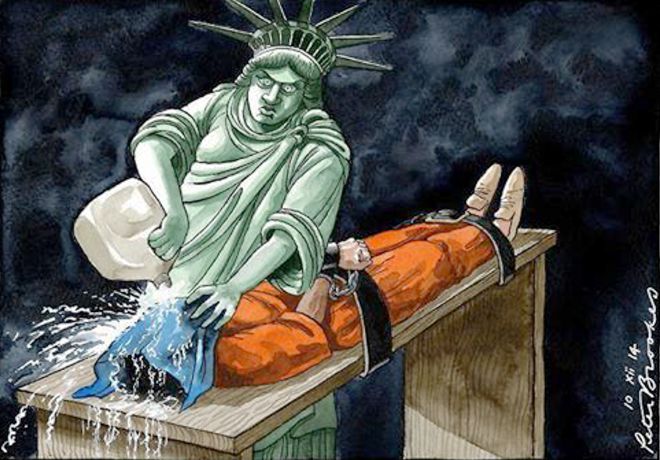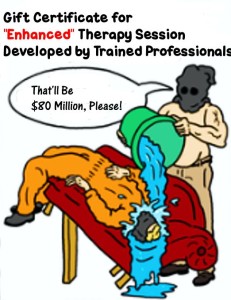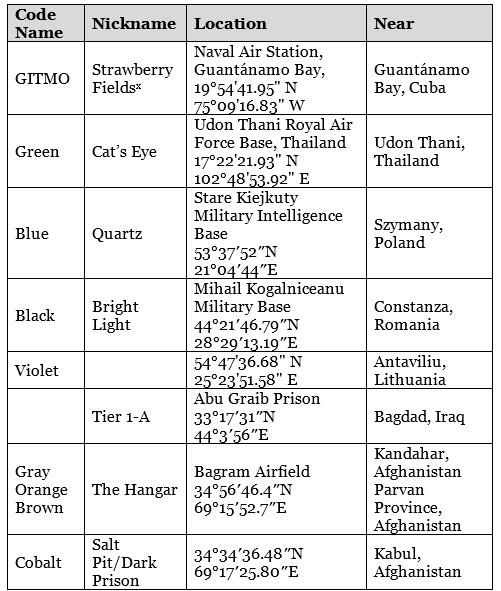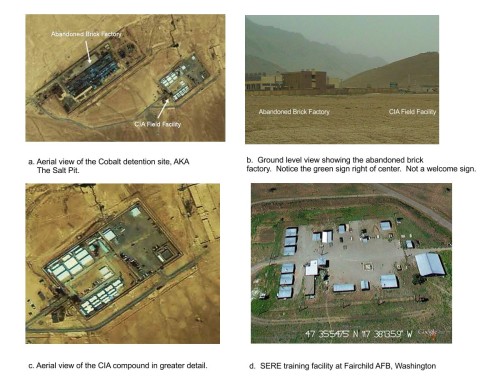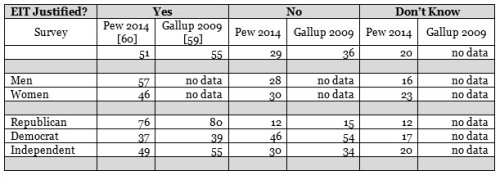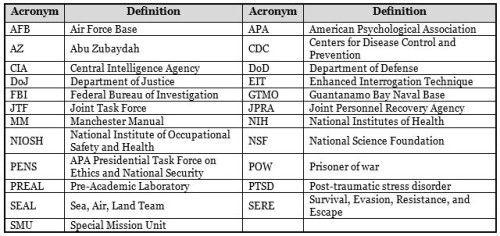Mitchell Jessen and Associates
In 2005, Mitchell Jessen and Associates was formed, with offices in Spokane and Reston, Virginia and included five additional shareholders, four of them from the military’s SERE program. David Ayers, Randall Spivey, James Sporleder, Roger Aldrich, , a legendary military survival trainer and Joseph Matarazzo, formed the core of the company. [34] Most troubling in this list is Matarazzo, a psychologist an emeritus professor at Oregon Health Sciences University and past President of the American Psychological Association. Although publically denying any day to day interaction with the company and disavowing the torture of terrorism suspects, Matarazzo’s participation is evidence of the close relationship of psychologists and the military. By 2007, the company employed about 60 people, some with impressive résumés, including Deuce Martinez, a lead CIA interrogator; Roger L. Aldrich; and Karen Gardner, a senior training official at the FBI Academy.
The base contract with Mitchell Jessen and Associates awarded in 2006 was in excess of $180M, of which the contractors received $81M prior to the termination of their $120M contract in 2009. In addition, the company and its employees received indemnification from legal liability arising from the program through 2021. The CIA has already paid out over $1M pursuant to the agreement.
The psychologists’ influence remained strong under four C.I.A. directors. In 2006, in fact, when Secretary of State Condoleezza Rice and her legal adviser, John B. Bellinger III, pushed back against the C.I.A.’s secret detention program and its methods, then CIA Director, Michael V. Hayden, asked Mitchell and Jessen to brief State Department officials and persuade them to drop their objections. They were unsuccessful. By then, the national debate over torture had begun, and the notoriety would undo the psychologists’ business.
In a statement to employees on April 9, 2009, Leon E. Panetta, President Barak Obama’s CIA director, announced the “decommissioning” of the agency’s secret jails and repeated a pledge not to use coercion. Additionally, Panetta stated that no CIA contractors will conduct interrogations. Agency officials terminated the contracts for Mitchell Jessen and Associates, and the psychologists’ lucrative seven-year ride was over. Within days, the company had vacated its Spokane offices and simply evaporated.
However, experience in the torture business was not a detriment to the career advancement of four of the company’s owners who now work at other firms that currently consult with the US government. Three of them — Spivey, Sporleder, and Aldrich — are still working together at a company called the Center For Personal Protection & Safety, which counts both the DoD and the FBI among its clients.
Mitchell and Jessen carried out their work at eight detention centers in the Middle East, Europe, and Southeast Asia, as well as Guantánamo Bay, Cuba. The CIA “black sites” are detailed in Table 1. The information is synthesized from the Senate report, and other sources. [35, 36]. In addition to the CIA “black sites” there were holding facilities in Morocco, Azerbaijan, Oman, Jordan, and Ethiopia, as well as 17 floating prisons including the USS Bataan, USS Peleliu, and USS Ashland.
Criticisms of Mitchell and Jessen
Mitchell and Jessen’s methods were so controversial that the reaction to their names alone became a litmus test of one’s attitude toward torture and human rights. Critics called them the “Mormon mafia” (a reference to their shared religion) and the “poster boys” (referring to the F.B.I.’s “most wanted” posters. [37]
Charles A. Morgan III, is an Associate Professor of Psychiatry at the Yale University School of Medicine, and is an expert on the effects of stress on the brain. Morgan’s research on the effects of the SERE program is well known and he is uniquely positioned to comment on the psychological effects of harsh interrogation tactics. Morgan was given access to graduates of the SERE school, and he has studied students immediately after they have undergone harsh interrogation tactics. In addition to in-depth interviews, he has collected blood and saliva samples to better understand the physiology of the response to tactics employed. Morgan has published his research in a number of peer-reviewed journals [38-46]. His research has shown that SERE interrogation techniques impair memory and prompt inaccurate answers from subjects. The interrogation techniques create a mental state that calls into question the credibility of any statements made while under the duress of SERE-like interrogation.
Morgan’s conclusions are supported by other researchers and published scientific papers [47, 48], and by authorities on the psychology of detention (Philip Zimbardo [49-56] of the Stanford Prison Experiment.) [52, 57] Nonetheless the CIA bought the Mitchell’s theory in spite of the contrary scientific evidence. The Senate report concluded that the abuses perpetrated by Mitchell and Jessen did not produce information useful in counterterrorism intelligence and had nothing to do with locating Osama bin Laden [22].
Reasons why Mitchell and Jessen were successful in selling EIT are complex, in part due to its congruence with how the Bush White House wanted to wage the new “global war on terror.” [26, 58]. The CIA was feeling considerable pressure to take action after 9/11 and were desperate for information about potential attacks. Mitchell and Jessen were good salesmen, and proved that aggressive attitudes and psychobabble can go a long way. James Risen in Pay Any Price also noted that Vice President DickCheney had a deeper motivation to support Mitchell and Jessen’s plan and that was toeliminate the reforms that had been placed on the executive branch in the wake of the Watergate scandal. Cheney wanted to demonstrate that there were virtually no limitations on presidential executive power in time of war. [26]
Michael Rolince, former section chief of the FBI’s International Terrorism Operations, described the methods employed as “voodoo science.” Steve Kleinman, an Air Force Reserve Colonel and expert in human-intelligence operations, found it astonishing that the CIA “chose two clinical psychologists who had no intelligence background whatsoever, who had never conducted an interrogation, to do something that had never been proven in the real world.” Kleinman also commented that, “I think they have caused more harm to American national security than they’ll ever understand.” [37]
American Psychological Association and the Military
An important part of the story of Jessen and Mitchell relates to the incident I discussed at the beginning of this article involving Martin Seligman and the contract he received from the Army. The DoD is the largest single employer of psychologists in the US, and has supported psychological research for decades. It is well known among academic psychologists that if your goal is to lasso a big grant, the easiest way to do it is to conduct research on a topic in which the military is interested. Unlike research grants awarded by the National Institutes of Health (NIH) and the National Science Foundation (NSF), the military often sends out requests for proposals (RFP) to conduct a particular type of research or address a particular issue. Respondents to such RFPs are carefully screened in advance and are often invited to submit proposals. This type of funding apparatus leaves the door open to all sorts of abuses and ethically questionable activities. Contracts from the DoD are particularly susceptible to this type of abuse.
Enter the American Psychological Association (APA). There has been a deep divide within the field of psychology about involvement in interrogation activities. Unlike the smaller American Psychiatric Association, the APA has never prohibited its members from being involved in interrogation. In 2002, subtle changes in ethics rules of the APA gave cover for psychologists to participate in harsh interrogations. The legal mumbo jumbo said that a psychologist could engage in activities that violated the APA code of ethics as long as the US government said the activities were legal. The APA rule change was essential to the Bush administrations use of EITs on detainees and it opened the door for Mitchell and Jessen.
The reason the APA made the rule change was not for Mitchell and Jessen, since they were not members, but because it had so much at stake in the relationship with the US defense machine. Grants and lucrative contracts paved the career path for many psychologists and no one wanted the money to dry up. By changing the rule the APA gave the Bush administration cover to use EITs, and insulated the administration from concerns about the lack of support for participation in interrogation by the American Psychiatric Association. The administration needed at least a tacit professional endorsement of torture and the APA gave it to them.
After the scandal at Abu Ghraib and the EITs became known, the APA needed to provide cover to the professionals involved in harsh interrogation. To do that an APA Presidential Task Force on Ethics and National Security (PENS) was formed. Their resulting report concluded that it was appropriate for psychologists to participate in interrogations to ensure that interrogation remained safe, legal, ethical, and effective. The PENS task force was made up of 10 members, 6 of whom were military officers or highly placed DoD contractors. One member was the chief psychologist for the US Special Forces. An attendee was a senior APA official who was married to a psychologist assigned to one of the military’s Behavioral Consultation Teams (military units involved in interrogations) at Guantánamo. [26] Many argue that the deck was stacked for an endorsement of the precedence of loosening US legal standards of torture and human rights. According to Jean Maria Arrigo, a social psychologist and member of the PENS Taskforce, the recommendations of the task force are a detailed description of Secretary of Defense Donald Rumsfeld’s definition of human treatment.
The conflict between psychologists and psychiatrists is centered on “prescription privileges.” Psychiatrists have them and psychologists don’t. The implications of this differences is profound and contribute to “prescription envy.” Why is this important in the context of Mitchel and Jessen? By giving the green light to psychologists participating in harsh interrogations, the APA gave the CIA, Department of Justice, and the Bush administration a publicly acceptable imprimatur for torture. Not only did the APA and its members continue in the good graces of the DoD, they also generated insider support within the DoD for granting prescription privileges to military psychologists. [37] Such a policy would come with significantly higher compensation, increased prestige, and reduced envy of psychiatrists. It is easy to see the importance of this quid pro quo.
In June 2010 a complaint was filed with the Texas State Board of Examiners of Psychologists against Mitchell [59] by a Texas psychologist, a Northwestern law professor, and an Austin, TX, lawyer. Even though Mitchell had never practiced in Texas, he maintained his license there. According to the complaint Mitchell “sullied his profession” by violating the standards demanded by the Psychologists’ Licensing Act 6 and the Board’s Rules of Practice. According to the complaint, Mitchell:
- Misrepresented his professional qualifications and experience to the CIA, and placed his own career and financial aspirations above the safety of others.
- Ignored the complete lack of a scientific basis for the EIT safety and effectiveness. and failed to take reasonable steps to ensure the safety of others.
- Tortured prisoners held in US custody and directly supervised others who engaged in torture.In the wake of the revelations about the tacit endorsement of torture by the APA in the 2005 PENS Report, the association has amended the ethics code and today holds the position that under no circumstance may APA standards by used to justify violating human rights. Still the question of prescription privileges for psychologists is unresolved.
- The charges against Mitchell were dismissed. Texas State Board of Examiners of Psychologists concluded that there was insufficient enough evidence to prove Mitchell violated rules of ethical conduct.
The Outcome
Save for a small number of advocacy groups speaking out against torture, a few intrepid journalists, and a handful of academics interested in human rights, Americans, in general, are blissfully ignorant of most of the atrocities perpetrated on prisoners in the “War on Terror” or they simply don’t care and have moved on to the next crisis de jour. Two polls, separated by 5 years shed some light on the opinion of Americans about the use of EITs. A Gallup Poll [60] conducted in 2009 and a Pew Research poll conducted in December 2014 after the release of the Senate report are astonishingly similar. Table 2 summarizes the results of these two polls on “Whether the use of Enhanced Interrogation Techniques was justified?”
Today, Mitchell is living in a suburb of Tampa in an $800,000 house paid for by the CIA. Jessen lives outside of Spokane. Mitchell and Jessen insist that they are not torturers, but they were doing something for their country. With a possible criminal inquiry looming, Mitchell and Jessen have retained a well-known defense lawyer, Henry F. Schuelke III. [21] Schuelke is well known as the special prosecutor in the corruption trial of Sen. Ted Stevens of Alaska.
There is a message in this story. It is one of “learned helplessness.” No, I don’t mean the kind induced by Mitchell and Jessen in prisoners of the War on Terror. It is the condition in which many of us find ourselves in today. In spite of all the attempts by politicians and the attendant rhetoric, it seems that many have given up on politics. To many of us, it seems that the bureaucracy is so large and inert that there is little the average citizen can do to change the course of events. Business entities control the country with the primary motive of increasing profit, at any cost. What was good for business was good for America was a maxim that held true, in part, through much of American history. Certainly, there were stunning examples of corruption, greed, and abuse, but these examples pale in comparison to what is going on today.
The agencies of government have grown so large that anonymity is relatively easy, and if you do commit an illegal or otherwise egregious act, there is little more than a light slap on the wrist. It is clear that nothing will be done to make fundamental changes in US policy to create an environment where “knee-jerk” reactions are not the first response to terrorism. Employing EITs on all detainees of the War on Terror will do little to make us safer. Little attention has been paid to the source of the anger that led the detainees to commit the horrendous acts in the first place. Taller fences, more airport screeners, more police, more weapons, etc., etc. does nothing to address the root problem. The US has consistently used force to achieved desired political ends (compliance with US demands, unfair trading practices, exploitation of resources, suppression of freedom of expression, etc.) without considering the long-term consequences. The popularity of the Jihadist movement throughout the world is testament to what we have done in the past, as well as the resurgence of a type of religious fundamentalism, not seen since the Crusades. Once the US stood for something uplifting, generous, and fair. Not so today, it is all about personal wealth, self-aggrandizement, and prestige.
References
- Seligman, M.E.P. and R.D. Fowler, Comprehensive Soldier Fitness and the future of psychology. American Psychologist, 2011. 66(1): p. 82-86.
- Seligman, M.E.P. and M.D.G.E. Matthews, Comprehensive Soldier Fitness. American Psychologist, 2011. 66(1): p. 1-86.
- Cornum, R., M.D. Matthews, and M.E.P. Seligman, Comprehensive Soldier Fitness: Building resilience in a challenging institutional context. American Psychologist, 2011. 66(1): p. 4-9.
- Fravell, M., K. Nasser, and R. Cornum, The Soldier Fitness Tracker: Global delivery of Comprehensive Soldier Fitness. American Psychologist, 2011. 66(1): p. 73-76.
- Casey, G.W., Jr., Comprehensive soldier fitness: A vision for psychological resilience in the U.S. Army. American Psychologist, 2011. 66(1): p. 1-3.
- Dyckman, J., Exposing the glosses in Seligman and Fowler’s (2011) straw-man arguments. American Psychologist, 2011. 66(7): p. 644-645.
- Eidelson, R., M. Pilisuk, and S. Soldz, The dark side of comprehensive soldier fitness. American Psychologist, 2011. 66(7): p. 643-644.
- Krueger, J.I., Shock without awe. American Psychologist, 2011. 66(7): p. 642-643.
- Phipps, S., Positive psychology and war: An oxymoron. American Psychologist, 2011. 66(7): p. 641-642.
- Quick, J.C., Missing: Critical and skeptical perspectives on comprehensive soldier fitness. American Psychologist, 2011. 66(7): p. 645-645.
- Seligman, M.E.P., Helping American soldiers in time of war: Reply to comments on the comprehensive soldier fitness special issue. American Psychologist, 2011. 66(7): p. 646-647.
- Benjamin, M. “War On Terror” Psychologist gets giant no-bid contract. 2014; Available from: http://www.salon.com/2010/10/14/army_contract_seligman/.
- Beccaria, C., An Essay on Crimes and Punishments. 1767, London: J. Almon.
- United States Department of Defense, Pre-Academic Laboratory (PREAL). 2002.
- Shane, S., Interrogation, Inc: 2 U.S. architects of harsh tactics in 9/11’s wake, in New York Times. 2009: New York.
- Mitchell, J.E., The Effectiveness of a High Potassium/Moderate Sodium Restriction Diet and Aerobic Exercise as Interventions for Borderline Hypertension (Blood Pressure), in Psychology. 1986, University of South Florida. p. 113
- Jessen, J.B., The Effect of Family Sculpting on Perceptual Agreement Among Family Members. 1979, Utah State University. p. 100.
- Worthington, A. The dark desires of Bruce Jessen, the architect of Bush’s torture program, as revealed by his former friend and colleague. 2011; Available from: http://www.andyworthington.co.uk/2011/03/28/the-dark-desires-of-bruce-jessen-the-architect-of-bushs-torture-program-as-revealed-by-his-former-friend-and-colleague/#g_main.
- Leopold, J. and J. Kaye. CIA psychologist’s notes reveal the true purpose behind Bush’s torture program. 2014; Available from: http://www.truth-out.org/news/item/205:exclusive-cia-psychologists-notes-reveal-true-purpose-behind-bushs-torture-program.
- Risen, J. and M. Apuzzo, C.I.A., on path to torture, chose haste over analysis, in New York Times. 2014: New York.
- Singal, J. Meet the psychologists who helped the CIA torture. 2014; Available from: http://nymag.com/scienceofus/2014/12/meet-the-shrinks-who-helped-the-cia-torture.html.
- Senate Select Committee on Intelligence, Committee Study of the Central Intelligence Agency’s Detention and Interrogation Program. 2014: Washington, DC.
- McCoy, A.W., A Question of Torture : CIA Interrogation, from the Cold War to the War On Terror. 2006, New York: Metropolitan Books/Henry Holt and Co. 290 p.
- Rizzo, J.A., Company Man: Thirty Years of Controversy and Crisis in the CIA. 2014, New York: Scribner. 320 pages
- Jessen, J.B., Psychological advances in trainng to survive captivity, interrogation and torture, in Advances in Clinical Psychological Support of National Security Affairs. nd.
- Risen, J., Pay Any Price : Greed, Power, and Endless War. 2014, Boston: Houghton Mifflin Harcourt. 285 pages.
- Press, A. Guantanamo detainees forced to listen to AC/DC, Barney. 2009 [cited 2015 1 January]; Available from: http://www.huffingtonpost.com/huff-wires/20081209/cb-prisoners-songs/ http://www.huffingtonpost.com/2008/12/09/guantanamo-detainees-forc_n_149706.html.
- Bybee, J.S., Interrogation of al Queda Operative. 2002, Department of Justice: Washington.
- Central Intelligence Agency. General. Interrogation Activities (September 2001 – October 2003 (2003-7123-IG). 2004 [cited 2015 3 January]; Available from: http://www2.gwu.edu/~nsarchiv/torturingdemocracy/documents/20040507.pdf.
- Smith, C.S. Welcome to ‘the disco’. 2009 [cited 2015 10 January]; Available from: http://www.theguardian.com/world/2008/jun/19/usa.guantanamo.
- Reyes, H., The worst scars are in the mind: Psychological torture. International Review of the Red Cross, 2007. 89(867): p. 591-617.
- Orwell, G., 1984. 1949, New York: Harcourt.
- Leopold, J. Zubaydah’s torture, Detention subject of Senate intelligence inquiry. 2010 [cited 2015 2 January]; Available from: http://truth-out.org/archive/component/k2/item/89080:zubaydahs-torture-detention-subject-of-senate-intelligence-inquiry.
- Walker, H. These 7 men owned the company linked to CIA torture. 2014 [cited 2015 2 January]; Available from: http://www.businessinsider.com/the-company-behind-cia-torture-2014-12.
- Goldman, A. and J. Tate. Decoding the secret black sites on the senate’s report on the CIA interrogation program. 2014 [cited 2015 2 January]; Available from: http://www.washingtonpost.com/blogs/worldviews/wp/2014/12/09/decoding-the-secret-black-sites-on-the-senates-report-on-the-cia-interrogation-program/?postshare=3411418143614830.
- Tate, R. Off the grid: Nine CIA “black sites” where detainees were tortured. 2014; Available from: https://firstlook.org/theintercept/2014/12/09/map-of-cia-black-sites/.
- Eban, K. Rorschach and awe. 2007 [cited 2015 6 January]; Available from: http://www.vanityfair.com/politics/features/2007/07/torture200707?printable=true¤tPage=all.
- Doran, A.P., G. Hoyt, and C.A. Morgan III, Survival, Evasion, Resistance, and Escape (SERE) training: preparing military members for the demands of captivity, in Military Psychology: Clinical and Operational Applications., C.H. Kennedy and E.A. Zillmer, Editors. 2006, Guilford Press: New York, NY, US. p. 241-261.
- Doran, A.P., et al., Survival, evasion, resistance, and escape (SERE) training: Preparing military members for the demands of captivity, in Military Psychology: Clinical and Operational Applications (2nd ed.). C.H. Kennedy and E.A. Zillmer, Editors. 2012, Guilford Press: New York, NY, US. p. 306-330.
- Lieberman, H.R., et al., The fog of war: Decrements in cognitive performance and mood associated with combat-like stress. Aviation, Space, and Environmental Medicine, 2005. 76(7,Sect2,Suppl): p. C7-C14.
- Morgan III, C.A., et al., Baseline dissociation and prospective success in special forces assessment and selection. Psychiatry, 2008. 5(7): p. 52-57.
- Morgan III, C.A., et al., Effect of carbohydrate administration on recovery from stress-induced deficits in cognitive function: A double-blind, placebo-controlled study of soldiers exposed to survival school stress. Military Medicine, 2009. 174(2): p. 132-138.
- Morgan III, C.A., et al., Hormone profiles in humans experiencing military survival training. Biological Psychiatry, 2000. 47(10): p. 891-901.
- Morgan III, C.A., et al., Plasma neuropeptide-Y concentrations in humans exposed to military survival training. Biological Psychiatry, 2000. 47(10): p. 902-909.
- Morgan III, C.A. and T.M. K., Spontaneous and deliberate dissociative states in military personnel: Are such states helpful? Journal of Traumatic Stress, 2013. 26(4): p. 492-497.
- Taylor, M.K., et al., Sex differences in cardiovascular and subjective stress reactions: Prospective evidence in a realistic military setting. Stress: The International Journal on the Biology of Stress, 2014. 17(1): p. 70-78.
- O’Mara, S., Torturing the brain: On the folk psychology and folk neurobiology motivating ‘enhanced and coercive interrogation techniques.’ Trends in Cognitive Sciences, 2009. 13(12): p. 497-500.
- Schiemann, J.W., Interrogational torture: Or how good guys get bad information with ugly methods. Political Research Quarterly, 2012. 65(1): p. 3-19.
- Bottoms, S., Timeless cruelty: performing the stanford prison experiment. Performance Research, 2014. 19(3): p. 162-175.
- Brady, F.N. and J.M. Logsdon, Zimbardo’s “Stanford Prison Experiment” and the relevance of social psychology for teaching business ethics. Journal of Business Ethics, 1988. 7(9): p. 703-710.
- Haney, C. and P. Zimbardo, The past and future of U.S. prison policy: Twenty-five years after the Stanford Prison Experiment. American Psychologist, 1998. 53(7): p. 709-727.
- Zimbardo, P.G., On the ethics of intervention in human psychological research: With special reference to the Stanford prison experiment. Cognition, 1973. 2(2): p. 243-256.
- Zimbardo, P.G., On rethinking the psychology of tyranny: The BBC prison study. British Journal of Social Psychology, 2006. 45(1): p. 47-53.
- Zimbardo, P.G., Thoughts on psychologists, ethics, and the use of torture in interrogations: Don’t ignore varying roles and complexities. Analyses of Social Issues & Public Policy, 2007. 7(1): p. 65-73.
- James, L.C., G.A. Freeman, and P.G. Zimbardo, Fixing Hell: An Army Psychologist Confronts Abu Ghraib. 2008, New York: Grand Central Pub. 286 p.
- Zimbardo, P.G., The Lucifer Effect : Understanding How Good People Turn Evil. 2007, New York: Random House. 551 p.
- Haney, C., C. Banks, and P. Zimbardo, Interpersonal dynamics in a simulated prison. International Journal of Criminology & Penology, 1973. 1(1): p. 69-97.
- Risen, J., State of War: The Secret History of the CIA and the Bush Administration. 2006, New York: Free Press. 240 p.
- Cox, J.L.H., 6-9-10 Complaint against Janes Elmer Mitchell. 2010.
- Jones, J.M. Slim majority wants Bush-era interrogations investigated. 2009 [cited 2015 7 January]; Available from: http://www.gallup.com/poll/118006/Slim-Majority-Wants-Bush-Era-Interrogations-Investigated.aspx.
Endnotes
[i] Acronyms used in this essay are:
[ii] Correcting for inflation means Mitchell retired with approximately a $50K per year pension.
[iii] According to NIOSH and the CDC permissible exposure time before there is risk of permanent hearing loss is 85dB for 8 hours, 88 dB for 4 hours, 91 dB for 2 hours, 94 dB for 1 hour, 97 dB for 30 minutes, or 100 dB for 15 minutes (about the volume of an mp3 player at full volume). http://www.dangerousdecibels.org/education/information-center/decibel-exposure-time-guidelines/
[iv] “I Love You” – The Barney Theme
“The Beautiful People” – Marilyn Manson
“Fuck Your God” – Deicide
“We Are Champions” – Queen
“Enter Sandman” – Metallica
“Bodies” – Drowning Pool
“Shoot to Thrill” – AC/DC
“Hell’s Bells” – AC/DC
“Born in the USA” Bruce Springsteen
“Babylon” – David Gray
“White America” – Eminem
[v] Cold cells are specially engineered rooms which are designed to be superchilled to 45-55 º F with special venting, air conditioners, and air handlers.
[vi] Five detainees, including AZ were subjected to rectal hydration and feeding. Typically, Ensure®. As well pureed hummus, pasta with sauce, nuts, and raisins were used. Detainees were placed in a supine position and their head lowered 15-30º prior to hydration and feeding.
EO Smith
Latest posts by EO Smith (see all)
- Patriotism - 4 July, 2017
- The Super Sucker Bowl - 10 February, 2017
- Alternative Facts and Science - 24 January, 2017


